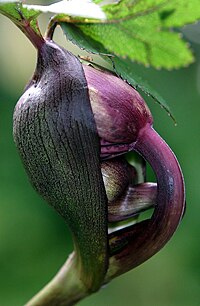Plant morphology

Plant morphology is the study of how plants look and grow. It's like looking at a plant and figuring out how it works!
Plants are made up of different parts. The parts you can see are the leaves, stems, and flowers. But, plants also have a lot of parts you can't see, like roots, which are hidden underground.
The leaves of a plant are often how we identify it. They come in all sorts of shapes and sizes. Some plants, like cactus, have small, spiky leaves. Others, like ferns, have large, leafy fronds. Leaves are important because they help the plant make food through a process called photosynthesis.
The stems hold up the leaves and flowers. Some plants have very thick stems, like trees, while others have thin, bendy stems, like grasses. Stems are like straws, they help transport water and nutrients from the roots up to the rest of the plant.
The flowers are where the plant makes seeds. Flowers come in all sorts of colors and shapes. Some plants have big, bright flowers that are really showy, while others have small, plain flowers. Flowers are how plants reproduce - they make seeds that grow into new plants.
Roots are what anchor the plant in the ground and absorb water and nutrients. Some plants have long, skinny roots that go deep into the soil, while others have shallow, branching roots that spread out. Roots are super important because they help the plant get the things it needs to grow.
So, that's plant morphology - it's all about understanding the different parts of a plant and how they work together to help the plant grow and survive.
Plants are made up of different parts. The parts you can see are the leaves, stems, and flowers. But, plants also have a lot of parts you can't see, like roots, which are hidden underground.
The leaves of a plant are often how we identify it. They come in all sorts of shapes and sizes. Some plants, like cactus, have small, spiky leaves. Others, like ferns, have large, leafy fronds. Leaves are important because they help the plant make food through a process called photosynthesis.
The stems hold up the leaves and flowers. Some plants have very thick stems, like trees, while others have thin, bendy stems, like grasses. Stems are like straws, they help transport water and nutrients from the roots up to the rest of the plant.
The flowers are where the plant makes seeds. Flowers come in all sorts of colors and shapes. Some plants have big, bright flowers that are really showy, while others have small, plain flowers. Flowers are how plants reproduce - they make seeds that grow into new plants.
Roots are what anchor the plant in the ground and absorb water and nutrients. Some plants have long, skinny roots that go deep into the soil, while others have shallow, branching roots that spread out. Roots are super important because they help the plant get the things it needs to grow.
So, that's plant morphology - it's all about understanding the different parts of a plant and how they work together to help the plant grow and survive.
Related topics others have asked about:
